

Inking the History of Nara Prefecture
|
墨は餓鬼に磨らせ、筆は鬼に持たせよ (sumi wa gaki ni surase, fude wa oni ni motaseyo) “Grind your inkstick gently, but move your brush vigorously.” -- This saying is a reminder to be aware of one’s conduct when practicing calligraphy, but it also features two of the art form’s most important implements: brush and ink. The art of calligraphy, or shodo (書道) as it is known in Japanese, is an art form that focuses on the beauty and balance of written characters. Experienced calligraphers handle their brushes with care, making sure each stroke makes a beautiful line, all while controlling how much ink is deposited on the paper. It goes without saying then that calligraphers seek out high quality brush and ink that they can best control in order to create their art pieces. For high quality brushes and ink, calligraphers need look no further than Nara Prefecture. Formerly known as Yamato, Nara was Japan’s first capital, spanning a few decades from 710 to 794 AD. Even before it was designated as a capital city, it was already functioning as a cultural and technological hub; historical records from neighbouring countries noted close contact with inhabitants of the area, and art and architecture flourished. With its ancient city and historical Buddhist temples, such as Horyuji and Todaiji, completed in the 7th and 8th centuries respectively, Nara has earned a well-deserved reputation as a living museum. It is through ancient Nara that the art of calligraphy, its techniques, and various implements were introduced to the rest of Japan. The monk Kobo Daishi (also known as Kukai), first introduced the Chinese Tang-style method of brush-making to Japan nearly 1,200 years ago. He taught these techniques to artisans who later made brushes for the Emperor Saga, who was well-known to be an accomplished calligrapher. The art of brush-making later proliferated throughout Japan, but it was Nara that soon came to be known as the centre of brush-making in the country. Nara is home to many temples and shrines - the monks and priests that served these temples and shrines were in need of brushes and ink for their studies, and as such, more brush makers set their bases in Nara to cater to this demand. |
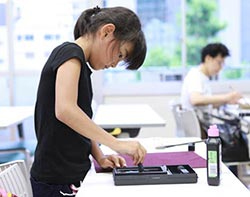 © Web Japan (Cooperation with Hakushu Shodo Kai) 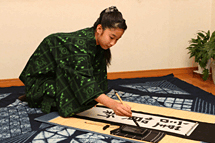 © AFLO 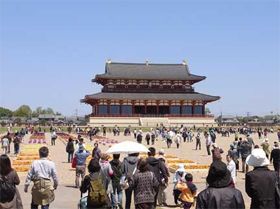 © Association for Commemorative Events of the 1300th Anniversary of Nara Heijo-kyo Capital 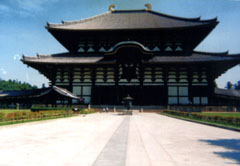 © Web Japan |
|
Although there are brush makers throughout the country, brushes made in Nara, known as Nara fude (奈良筆), stand out due to the materials and techniques used by artisans. Different materials can achieve strokes that look very different. For example, brushes made of sheep or goat hair can hold a lot of ink, and create gentle sweeping lines, while brushes made with feathers can create lines that are sharper. With Nara brushes, makers use a combination of 10 types of animal hair - including hair from sheep, horses, deer, tanuki (raccoon dogs), weasels, Japanese martens, rabbits, and squirrels - to achieve a brush that is able to hold large quantities of ink, yet maintain an ideal density that is neither too hard nor too soft.
Nara brushes are also made using a traditional method known as nerimaze-ho (練り混ぜ法). Brush makers soak every single strand of raw animal hair in water. After the hairs have hardened, they are sorted based on certain characteristics, such as softness, thickness, and length. The flexibility of the hairs are also taken into account; certain parts of the brush need more firmness, while others need hairs that are more flexible. Brush makers hand-select each hair that goes into the brushes they make, combing through the hairs they have prepared to make sure they come up with the right combination of textures and lengths to make the perfect brush. Though it is time-consuming, this technique is used even till today. The attention to detail that the artisans put into making each brush has earned Nara brushes high praise from calligraphers, calligraphy experts, and admirers alike. Ink making is another traditional industry that naturally flourished alongside brush making in Nara. There are two main types of ink, or sumi (墨) as it is known in Japanese, produced in Japan: shoenzumi (松煙墨), which is made by burning pine resin, and yuenzumi (油煙墨), which is made by burning rapeseed, sesame, or paulownia oil. The type of ink manufactured in Nara is of the yuenzumi variety, and its method was also introduced via the monk Kobo Daishi together with Chinese brush-making techniques. To make ink, animal glue is first melted and kneaded together with soot. Fragrances, such as that of camphor, are mixed into this blend to get rid of the smell of glue. It is kneaded roughly and thoroughly in a machine for 30-40 minutes to prevent it from getting aerated. Later, the mixture is kneaded by hand, and stretched to the desired length and pressed into a mold. This mixture is then left to dry between pieces of charcoal and paper. This drying process can take between a week to twenty days as the ink makers have to be careful not to crack the surface of the mixture. When the mixture is dried to a certain extent, it is wrapped with straw and hung from the ceiling to dry out even further for up to three months. Once it is completely dry, it is washed and polished, and left to dry one last time before they are sold as ink sticks. Nara ink sticks are unique in that they are often shaped by hand, or pressed in a wooden mold that are unique to Nara ink makers. The demand for ink in Nara used to be high; the priests and monks that resided in the many temples in the area needed ink for academic purposes, and to copy sutras. Indeed, many ink manufacturers were centred around Kofukiji Temple during the Heian period. Though the ink industry has declined, Nara Prefecture still accounts for 90% of the high quality ink produced nationwide. |
 © Web Japan 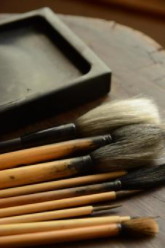 © photoAC 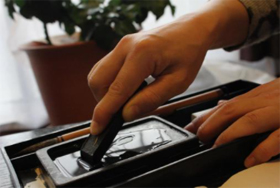 © photoAC 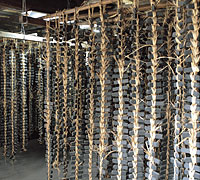 © Web Japan 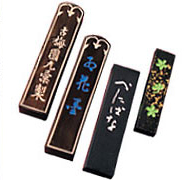 © Web Japan |
| With the preservation of long-established techniques that ensure smooth writing, it is no wonder that calligraphers all over Japan and the world hold these products from Nara in such high prestige. If you are a budding calligrapher in need of brushes and ink, do give Nara-made brushes and ink a try! |
Resources
|
Nara Brushes. (2014). Retrieved 25 January 2021, from https://japan-brand.jnto.go.jp/crafts/other_craft/2824/ |
|
Japan Creative Centre 4 Nassim Road, Singapore 258372 +65 6737 0434 / jcc@sn.mofa.go.jp https://www.sg.emb-japan.go.jp/JCC/ Nearest parking at Orchard Hotel & Delphi Orchard |
 |